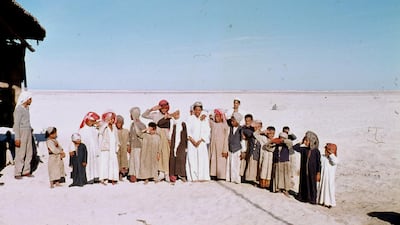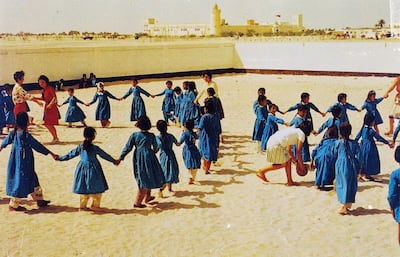A group of boys – and a single girl – pose for a western photographer in Abu Dhabi in December 1957. Their ages range from perhaps five or six to the early teens. The rhythm of their lives has not changed for decades, even centuries.
That is about to end.
Some of this group may be unable to read or write. The more fortunate will have received a basic education that consists solely of reading the Quran in the community’s only school.
Within a few years, though, all will be offered a chance to play their part in the country’s transformation to the one we know today. Some may become businessmen, financiers, diplomats, engineers. Education will be the key.
The start of that transformation is seen in a photograph shared recently by Sheikh Mohammed bin Rashid, the Vice President of the UAE and Ruler of Dubai, on his Twitter account.
It shows a boy at school, with his teacher, copying on a blackboard in Arabic the phrase: “Justice is the foundation of the king”.
The young pupil is Sheikh Mohammed bin Zayed, Crown Prince of Abu Dhabi and Deputy Supreme Commander of the UAE Armed Forces.
The photograph is undated, but given the age of Sheikh Mohammed in the photo, it is likely taken in the late '60s. It is possibly in Al Ain, where the Crown Prince was born, although by then his father, the late Sheikh Zayed, was now Ruler of Abu Dhabi.
It was in Al Ain where Sheikh Zayed, then Ruler’s Representative in the Eastern Region, set up Al Nahyaniah primary school in 1959, the emirate’s first government school.
In Abu Dhabi town, education was largely down to the efforts of one man, Darwish bin Karam, whose childhood was spent as a pearl fisher until at the age of 12, he was given a place at a school in Dubai and realised his true passion was learning.
Bin Karam, whose service to the community was honoured with a posthumous Abu Dhabi Award in 2008, created Al Ahlia school, offering Islamic studies in a single class that would have combined literacy in Arabic with some basic maths.

Mohammed Al Fahim recalls the thrill of attending the school in 1956 in his book Rags to Riches. "I remember being so excited about going to school that I would sleep fully dressed so as not to waste any time with preparations in the morning."
Classes began around 6am, he remembered, ending at about noon, with an hour’s break for breakfast between 8am and 9am.
He wrote that in the classroom “both boys and girls sat silently reading, each struggling over a different page of the Quran. In fact our entire education consisted solely of reading the Holy Book”.
Abu Dhabi’s first formal school opened in 1959, in a long, narrow six-room building previously used as a warehouse on a site next to what is now the British Embassy.
Donated by the British authorities to the then Ruler, Sheikh Shakhbut bin Sultan, it lacked sanitation, air conditioning and even textbooks.
Mr Al Fahim describes the sole teacher, a Palestinian from Jordan, who was forced to sleep in the building because of a lack of accommodation. During the day he struggled to impose discipline and attempted to call a register for pupils who sometimes did not know their full names or even their exact ages.
The only textbook was owned by the teacher, although the school had desks and chalkboards. Pupils purchased notebooks and pencils in the nearby souk.
Ahmed Al Khoori was also part of the first generation to attend the new school.
“It had no electricity, no water, only a blackboard,” he says.
But while some criticised the poor facilities, he said: “At least it was built. And it was better than nothing. We were taught Arabic, a little English and a little maths."
Education was up to grade 5, or the end of elementary education. The new school taught only boys. Girls' education in Abu Dhabi would wait several years, opening around late 1963 at a site next to Qasr Al Hosn, near the present junction of Hamdan Street and Airport Road. A primary school followed five years later.
The school’s first headteachers were Noura Al Shamsi and Moza Habroush, with the teaching staff including a Bahrainian, Qudsia Hussain Redha Rafii.
Recruiting qualified teachers was not always straightforward. A report by the British political agent to the residency in Bahrain in the summer of 1962 noted that a group of Jordanian teachers had been sent home in disgrace by Sheikh Shakhbut.
The confidential letter describes the Ruler’s decision as: “A wise one, for they were, on the whole, a scruffy and unruly bunch, led by a perpetually unwashed and unshaved, sadistic and foul-minded headmaster”.
One problem in attracting teachers to work in the region in those times was a lack of accommodation. Another was low pay.
In the end, new teachers were recruited with improved packages that offered 1,000 Gulf rupees a month –the currency used at that time – for the headmaster and 650 rupees to teachers, the equivalent of Dh360 and Dh234, respectively.
Education for both girls and boys spread rapidly across the Emirates in the late 1950s and '60s. Formal education began in Sharjah in 1953, though Dubai’s Al Ahmadiya School, now a museum, can trace its origins back to 1912.
By 1963, the city’s expatriate community had grown large enough to support its own school, with Dubai English Speaking School set up in a villa with 10 pupils taught by Royal Air Force education corps officer Freddy Loughman.
In Abu Dhabi, the Al Khubairat Community School opened on an area of land donated by the Ruler in 1968. It later became known as The British School Al Khubairat.
Girls were already being educated in Dubai, Ras Al Khaimah and Sharjah by the 1950s, and by the mid-1960s in Umm Al Quwain, Ajman and Fujairah.
_______________
Read more:
Dubai's newest higher education institute attracts students with designs on the future
UAE pupils beat odds to get high scores in tough A-level exams
Summer learning: the campaign encouraging children to try something new
_______________
By 1964, records show that Abu Dhabi was educating 390 boys and 138 girls, with a teaching staff of 33.
Soon a new school year will begin in the UAE, welcoming hundreds of thousands of pupils at thousands of schools. They still include Al Nahyaniah in Al Ain, Dubai English Speaking School and the British School Al Khubairat. Al Alhia School is now relocated off the island and renamed Darwish bin Karam School after the pioneering educator.
Mohammed Al Fahim, the boy who slept in his clothes to get to school quicker, is part of a billion-dollar family business empire that ranges across travel, shopping and luxury car dealerships. His book has been translated into nearly a dozen languages.
Ahmed Al Khoori recalls that as a child, people laughed when he spoke of his ambition to become an engineer. After finishing school he was part of the first generation sent overseas for higher education by Sheikh Zayed.
He retired after a lifetime serving Abu Dhabi’s onshore oil company, where he was a mentor to younger employees.
As the Arabic proverb says: “A tree begins with a seed”.



